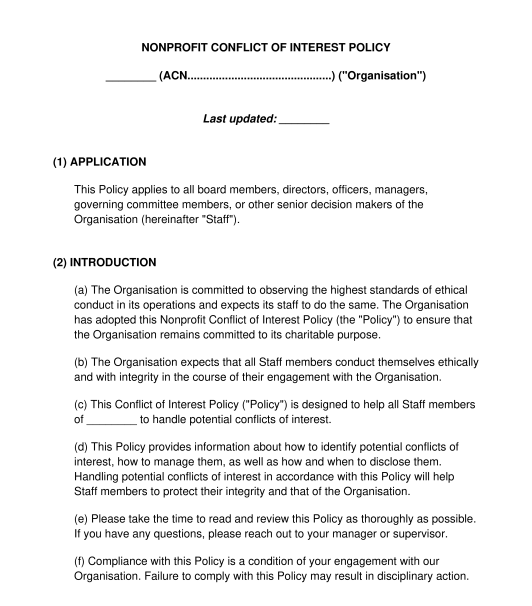 31/10/2025
31/10/2025

Answer a few questions and your document is created automatically.

Your document is ready! You will receive it in Word and PDF formats. You will be able to modify it.

 31/10/2025
31/10/2025
 Word and PDF
Word and PDF
 6 to 10 pages
6 to 10 pages
A Conflict of Interest Policy for Nonprofit is a document used by a nonprofit organisation to describe when their directors or other senior staff might face a conflict of interest. Usually, these documents also describe how staff can report a potential conflict.
Conflicts involve situations where the staff member may be motivated by something other than their work for the organisation. All nonprofits, even small ones, should consider having a comprehensive Conflict of Interest Policy for their staff.
In addition to a Conflict of Interest Policy, many nonprofit organisations have other documents to address various other matters related to the organisation. We have a number of these types of documents available for download, including a Volunteer Agreement, Donation Agreement, Employment Agreement (or Letter of Offer of Employment), Confidentiality Agreement, Non-Compete Agreement, Employee Handbook, Drug and Alcohol Policy, Social Media Policy, Remote Work Policy and a Discrimination Policy. These documents can work in conjunction with the Conflict of Interest Policy.
This Conflict of Interest Policy for Nonprofit is designed for use by charities or nonprofits. These sorts of organisations might choose to use this document with their employees, directors or other senior staff. Charities have some specific rules that they need to comply with in order to maintain their charitable status under Australian law. They may use this policy as part of their strategy to ensure they are complying with those laws.
Alternatively, we also offer a general Conflict of Interest Policy which may be used by other employers (which are not charities or nonprofits). For example, it may be used by companies that are operating for profit and are not bound by Australian charities law.
This document should be used by a nonprofit organisation that wants to set out their rules regarding conflicts of interest.
The organisation can enter their relevant details at the start of the document, and can select various options throughout the document to adapt it to their particular circumstances.
Once the document has been completed, it can be made available to staff. It may be provided to staff when they first start working with the organisation. For existing staff, it may be distributed, together with a message to notify them that this document outlines the Employer's updated approach to conflicts of interest.
In any event, it is important that the details of this Policy are actually communicated to staff, and that staff actually understand what is expected of them. An easy way to do this is by sending a Letter to Employees About New or Updated Workplace Policies.
Some organisations choose to have staff sign a copy of the document, to confirm that they have read and understood it. Signed copies may be kept on file by the organisation. This document has an option to include space for staff to sign it.
The organisation should ensure that the document accurately reflects their actual approach to these matters. The organisation should also make sure that staff understand what the document says. The purpose of this document is to avoid conflicts of interest, so to achieve that, it is important that the organisation and the staff members take the time to understand the document, and to make sure they comply with it.
In some organisations, there is a temptation to prepare these sorts of documents, get staff to sign them, and then file them away and never think of them again. In other words, they are treated as a "tick and flick" exercise. This should be avoided, and instead the organisation should use the document as an opportunity to educate their staff and to develop a positive culture that avoids conflicts of interest.
Some organisations also choose to make reference to this Policy within their Employment Contract.
The Australian Charities and Not-for-profits Commission ("ACNC") governs charities in Australia.
If the organisation is registered as a charity in Australia then it will need to comply with the ACNC's governance standards. Compliance with the governance standards is a requirement of registration with the ACNC. Under governance standard 5, a charity is required to ensure that its board members are aware of and are subject to a set of duties, including a duty to disclose actual or perceived conflicts of interest.
You fill out a form. The document is created before your eyes as you respond to the questions.
At the end, you receive it in Word and PDF formats. You can modify it and reuse it.
Conflict of Interest Policy for Nonprofit - template
Country: Australia